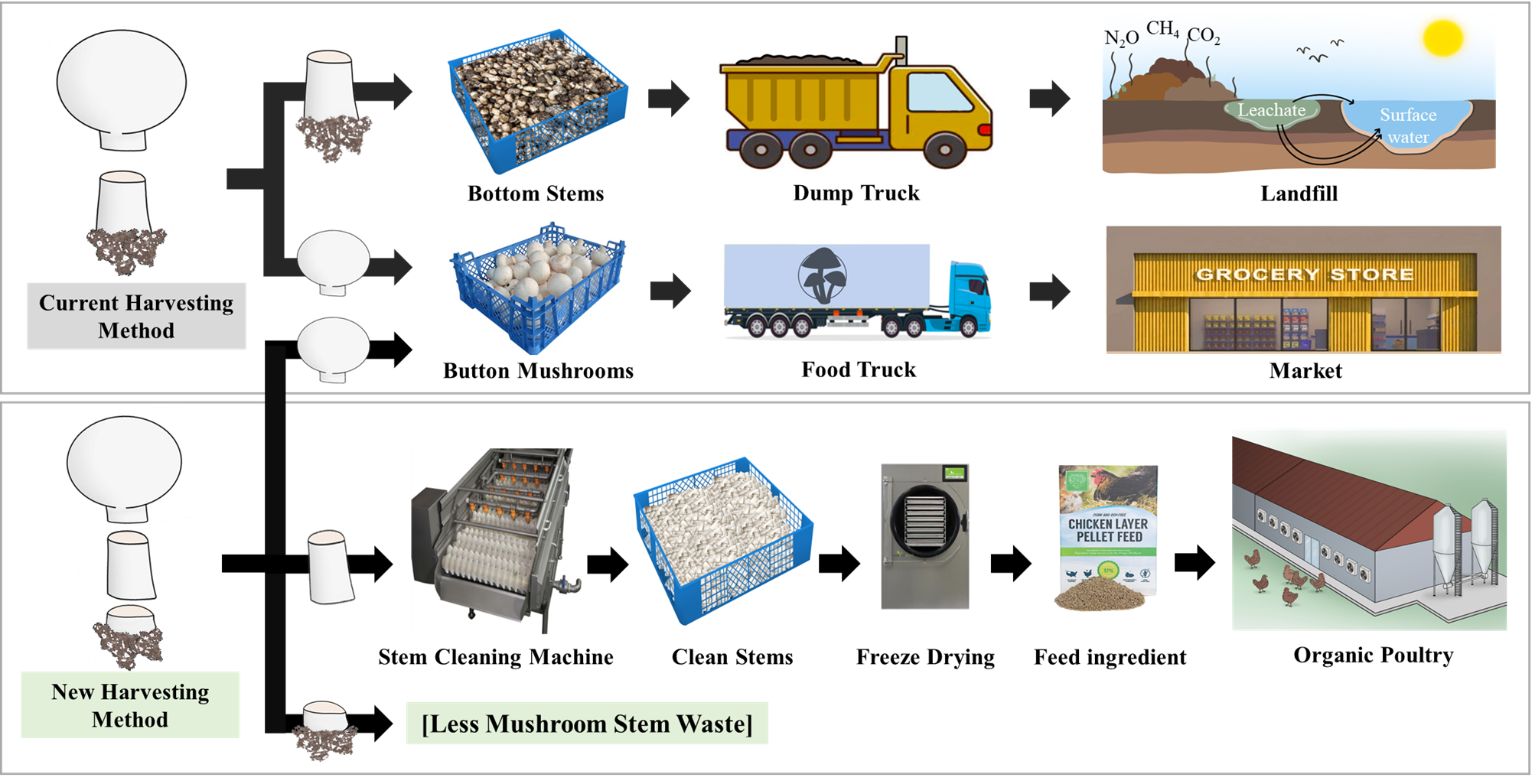
A team of researchers is exploring the possibility of adding dried mushrooms to chicken feed. This initiative could potentially cut costs for poultry and egg producers. Moreover, adding mushrooms to poultry feed could improve the health of the chickens, as well as the quality of the meat and the eggs they produce, which in turn would benefit the end consumer.
Venkatesh Balan, associate professor with the Department of Engineering Technology at the University of Houston (UH), and his colleague, Weihang Zhu, professor of mechanical engineering technology at UH, were recently awarded $750,000 of a $2 million grant by the USDA National Institute of Food and Agriculture (NIFA) to conduct research into the development of this new poultry feed additive made from mushrooms.
This work is part of a larger partnership between the University of Houston, Prairie View A&M University, and the University of Georgia.
Prior to his life in academia and research, Balan owned a mushroom farm in his native country of India. His knowledge of the industry and of the methods employed to harvest mushrooms, made him wonder if there might be a better way to deal with all the waste generated whenever mushrooms are harvested.
“I visited numerous mushroom producing facilities around the world,” he explains, “and wherever I would go, I saw the same thing: All the mushroom stems were discarded after each harvest. So I thought to myself that turning this waste into animal feed might be a great opportunity.”
Balan says that the mushroom industry regularly discards many tonnes of mushroom stems. He and his research partners believe that these stems could be processed and turned into valuable and nutritious chicken feed. He calls it a “trash to gold” scenario.
Focus on chickens
According to Balan, you can add mushrooms to the feed of a number of different animals, “but we focused on chickens because they’re not picky eaters,” he says.
However, there’s a much more interesting and serious reason why mushrooms can benefit chickens. “The poultry industry used to give an extensive amount of antibiotics to their animals, and too many antibiotics leads to antibiotic secretion in the faeces, and it creates superbugs,” Balan explains. “So that’s why antibiotics were banned in the poultry industry.”
Naturally, this ban created problems for poultry producers who were left wondering where to find an alternative to antibiotics. “Amazingly enough,” Balan says, “they discovered that feeding chickens with yeast helps them overcome infections. So over the last ten years, whenever you see antibiotic-free chicken being marketed, that’s because of the yeast.”
Mushrooms and yeast are “cousins,” as Balan puts it, which led him and his fellow researchers to wonder if mushrooms could be just as effective as yeast in preventing disease in poultry. “That’s how this idea with mushrooms started,” he adds.
With the funding in place, researchers began collecting the waste mushrooms stems in bulk, cleaning them, freeze-drying them in order to preserve the nutrients, and then grinding them into a powder before adding the final product to chicken feed.
Although any type of mushroom will do, Balan says that button mushrooms (Agaricus bisporus) make up about 80% of the mushroom industry in North America, which is why these researchers have partnered with button mushroom producers, and are collecting their waste stems, which can amount to as much as 40 tonnes per day.
Eventually, Balan hopes to include other mushroom species in this research. “The next biggest mushroom industry is shiitake and oyster,” he explains. “The next thing we would like to look into is the effect of different types of mushrooms on poultry, because different species of mushrooms have different nutritional elements, different active compounds, and different immune-modulating compounds. So we need to evaluate those differences down the road.”
Solving multiple problems
Adding mushrooms to chicken feed solves a number of problems. First, the waste stems can we repurposed, which means they don’t end up in a landfill. Furthermore, mushroom farmers can potentially earn extra income by selling these waste products.
Second, because of the medicinal value of mushrooms, chickens who consumer this feed should be better able to fight off disease without antibiotics. Moreover, the quality of the eggs and of the chicken meat should also improve. “If we feed the chickens with mushrooms, thanks to all the nutraceutical benefits, the quality of the meat and the quality of the eggs will improve,” Balan explains. “So not only is feed with mushrooms a health benefit for the chicken, but it’s also a health benefit for the people who end up eating the chicken and the eggs.”
Third, the soybeans and corn usually fed to chickens can be repurposed for human consumption. “When it comes to feed, right now we are solely dependent on soybean and corn,” Balan adds, “but the human population is growing and there is a limit to how much we can produce because of climate change and other factors. Since we are using soybeans to feed humans too, the available raw material for animal feed is decreasing.”
Conventional chicken feed, Balan explains, is 60 per cent cereals, 10 per cent nutritional additives, and 30 per cent vegetable protein and soybeans. “We want to change this composition by adding dry mushroom stems as a feed ingredient,” he adds.
The perfect middleman
Right now, Balan and his team of researchers are collecting the hard data that stakeholders in the poultry industry need to see in order to ascertain the benefits of adding mushrooms to chicken feed.
“The farmers are pretty open to this idea, just as long as the feed is comparable to that of soybean, and as long as it’s affordable,” he adds. “Moreover, if adding mushrooms has additional health benefits, they’re eager to see the data, and if it’s convincing, they’re willing to switch.”
Balan says he’s not trying to reinvent the wheel. “The mushroom industry is already there,” he says, “and the chicken industry is already there. So we’re not inventing something new. We are basically bringing them together. We’re like the middleman trying to connect these two industries.”
As exciting as the possibilities may be, Balan isn’t promising results overnight. It’s going to take a few years to bring this mushroom additive to market. “It’s probably going to take us three to five years,” he says. “We need to do the experiments so that we can collect the data to prove that this is not harmful. We also need to prove the health benefits for the chickens, and we need to show that the chicken meat and eggs have a higher nutritional value. If we can prove all this, then people will be more inclined to try it.”
Other stakeholders in this food chain are the feed companies. “We also need to convince the feed industry,” Balan adds. “They will be looking at the economics of processing the mushroom stems.”
In the end, Balan is confident that everyone involved in this supply chain will see the bigger picture and realize that it’s a win-win situation for all parties. “The mushroom producers get an additional revenue stream, because right now they’re throwing the stems in the trash,” he explains. “The farmers get sustainable feed, which will improve the health and immunity of their chickens, while improving the quality of the meat and the eggs. That’s the beauty of this product: Everybody wins.”
Print this page
